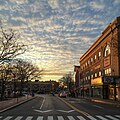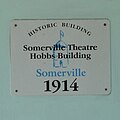
A movie theater, cinema, or cinema hall, also known as a movie house, picture house, the movies, the pictures, picture theater, the silver screen, the big screen, or simply theater is a business that contains auditoria for viewing films for public entertainment. Most, but not all, movie theaters are commercial operations catering to the general public, who attend by purchasing tickets.

Cinerama is a widescreen process that originally projected images simultaneously from three synchronized 35mm projectors onto a huge, deeply curved screen, subtending 146-degrees of arc. The trademarked process was marketed by the Cinerama corporation. It was the first of several novel processes introduced during the 1950s when the movie industry was reacting to competition from television. Cinerama was presented to the public as a theatrical event, with reserved seating and printed programs, and audience members often dressed in their best attire for the evening.
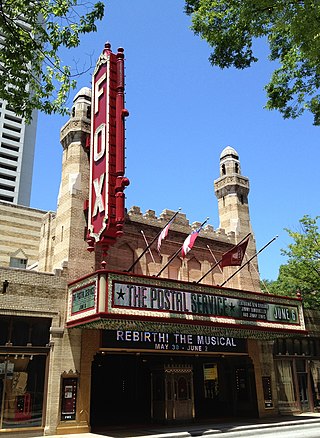
The Fox Theatre, a former movie palace, is a performing arts venue located at 660 Peachtree Street NE in Midtown Atlanta, Georgia, and is the centerpiece of the Fox Theatre Historic District.

The Hollywood Theatre is a historic movie theater in northeast Portland, Oregon, owned by a non-profit organization. It is a central historical landmark of the Hollywood District. The Theatre is located at 4122 NE Sandy Blvd, across the street from the first suburban Fred Meyer store, which is currently occupied by Rite Aid. The Hollywood Theatre was placed on the National Register of Historic Places in 1983 and is considered to be a gem of Northeast Portland's historic culture and tradition.

The Maryland Theatre is a music and entertainment venue located in the Arts and Entertainment District of downtown Hagerstown, Maryland. It was built in 1915, partially destroyed by fire in 1974, reopened in 1978, and expanded into a full performing arts complex in 2019. The theatre's seating capacity is 1,279 people, and it hosts performances of symphony orchestras, country artists, comedians, children's shows, pop stars, recitals, stage shows, and others. Over 81,000 patrons attended performances at the Maryland Theatre in 2005, making it one of Maryland's premier venues for the performing arts. The Maryland Symphony Orchestra performs there regularly and has been headquartered in the building since 2019. The theater features a fully restored Wurlitzer theatre organ.

An atmospheric theatre is a type of movie palace design which was popular in the late 1920s. Atmospheric theatres were designed and decorated to evoke the feeling of a particular time and place for patrons, through the use of projectors, architectural elements and ornamentation that evoked a sense of being outdoors. This was intended to make the patron a more active participant in the setting.


The Scranton Cultural Center at the Masonic Temple is a theatre and cultural center in Scranton, Pennsylvania. The Cultural Center's mission statement is "to rejuvenate a national architectural structure as a regional center for arts, education and community activities appealing to all ages." The Cultural Center hosts national Broadway tours; professional and local musical and dramatic theatre offerings; local, regional and national orchestral and popular music, dance and opera; comedians, lecturers, art exhibits, a children's and performing arts academy and various classes as well as fundraiser galas and special events including proms, luncheons, private parties and is a popular wedding ceremony and reception venue. It is listed on the National Register of Historic Places.

The Hibernian Hall is a historic building at 182-186 Dudley Street in the Roxbury neighborhood of Boston, Massachusetts. The four story brick building was designed by Edward Thomas Patrick Graham, and built in 1913 for the Ancient Order of Hibernians, an Irish Catholic fraternal organization. It was the first of several Hibernian halls to be built in Roxbury, it is now one of only two Irish dance halls from the period to survive. Its ground floor was originally occupied by storefronts, with offices of the organization and a banquet hall on the second floor, and a large hall on the third floor, which included a fourth-floor balcony. It remained a gathering place for local Irish residents through the 1960s, and was taken by foreclosure in 1960. It was then taken over by a non-profit focused on job training for local African Americans, which operated there until 1989. The building interior has suffered due to neglect and vandalism, but the basic form of the upper concert hall has survived.
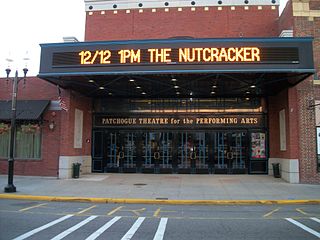
Patchogue Theatre for the Performing Arts is Located at 71 East Main Street in Patchogue Village, Suffolk County, New York.

The Music Box Theatre is a historic movie theater located in Chicago, Illinois. Built in 1929, it has been operating continuously as an art-house and repertory cinema since the early 1980s.

Artisphere was an arts center located in the Rosslyn section of Arlington, Virginia. The center encompassed four performance venues, three visual art galleries, an artist in residence studio, a 4,000 square foot ballroom, studio space, social gathering spots, food service facilities, a bar and lounge area as well as outdoor terraces. Programming includes visual art, theatre, live music, film, new media, family programs, dance, conferences and private events.
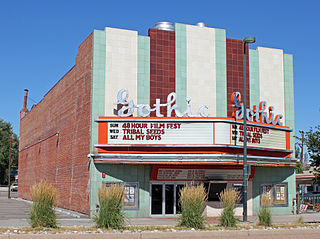
The Gothic Theatre is a former movie theater turned music venue in Englewood, Colorado. It was built in the 1920s and revitalized in 1998. Since the theater re-opened in 1998, it has held an abundance of events, ranging from local concerts to private events and film showcases.

The Granada Theater is a theatre located in Lower Greenville, in Dallas, TX. The theatre was built in 1946 as a movie house. In 1977, it was converted to a concert hall, only to revert to a movie theater soon after. In 2004 it was again opened as a concert hall.

The Scottish Rites Bodies Regency Center is a multi-use events venue located in San Francisco. at the intersection of Van Ness Avenue and Sutter Street. It opened in 1909 as a masonic lodge. In later years, it has served as a dance studio and movie theatre.

The Trylon Cinema is a 90-seat movie theater in the Longfellow neighborhood of Minneapolis, Minnesota. The cinema was founded and is currently run by Take-Up Productions, a group of volunteers who got their start at the Oak Street Cinema before establishing the Trylon in 2009 within a former warehouse. A 2017 expansion resulted in an increase in the cinema's seating capacity and accessibility. Throughout its history, the venue has featured a variety of regular programming, ranging from career retrospectives of famous directors to B movies and cult films. The Trylon has been well received by critics who have praised its film lineup, intimacy, and atmosphere.

The Lyric Center for the Arts, is a historic theater in Virginia, Minnesota. The theater was originally built as a vaudeville/movie theater and opera house in 1912. Architects Franklin Ellerbe, Olin Round and William Sullivan,, designed the building in 1911. Virginia businessman, Henry Sigel commissioned the architects to design an opera house to be built on the site of the McGarry Hotel, which burned to the ground during the catastrophic fire in Virginia in 1900.

Sony Hall is a concert venue operated by Blue Note Entertainment Group located on West 46th Street in the Theater District, Manhattan, New York City. Like many theaters in NYC, it has served many functions since its opening in 1938. Located in the basement of the Paramount Hotel, it began as Billy Rose's Diamond Horseshoe nightclub where the 1945 film Diamond Horseshoe was filmed, and later spent time as a burlesque theater before becoming a legitimate Broadway theatre under the names Century Theatre, Mayfair Theatre, and Stairway Theatre. As a Broadway theater, it is most well known for the transfer of the Tony Award-winning original Broadway production of On Golden Pond in 1979. After becoming a private venue through the 1980s and remaining mostly closed through the 1990s and 2000s, it reemerged in 2013 after a 20-million-dollar renovation as a theater hosting the immersive production Queen of the Night. It is currently run as a live music performance venue showcasing audio and visual technology by Sony.





